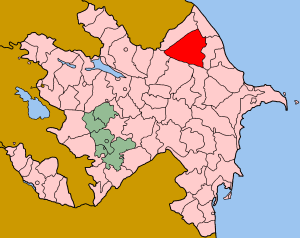Quba District (Azerbaijan)
- For other meanings see Guba.

Quba (also known as Guba and Kuba) is a city and a rayon in northeastern Azerbaijan. It is located on the Kudyal River at 41.37°N, 48.50°E.The mayor of this village is Ramil Rakhamimov.
The fertile region surrounding Quba is best known for its production of apples, the city of Quba is known for its fine carpets.
Demographis
Population
Languages
%
Religion
General information
| General information | |
|---|---|
| Total territory, [sq.km] | 2610.00 |
| Total number of population | 143100 |
| Number of villages | 155 |
| Number of settlements | 2 |
| Number of hospitals and medical enterprises | 16 |
| Number of culture centers | 194 |
Names of cities and big settlements
- Guba city
- Gonagkend district
- Gyrmyzy gesebe district
Names of border districts, countries and territories
Ismailly, Shamakhi, Gabala, Gusar, Khachmaz, Devechi, Khizi
History
Quba rose to prominence in the 18th century. In 1747, Nadir Shah ruler of the Persian Empire was assassinated. That same year, Hussein-Ali, the Shah's designated ruler of the region, decided to attempt to unify the Azeri khanates as an independent kingdom. One of his first moves was moving his capital from the less defensible Xudat in the Caspian lowlands to Quba where he built a fortress. Hussein-Ali died in 1757 and his son Fatali Khan carried on the expansion with Quba reaping the riches of its status as the capital. Some ruins from this period, such as Çirax Qala on the way to Baku, exist today.
However, upon Fatali Khan's death in 1789, the city's fortunes began to turn. In 1806, the khanate was occupied and soon absorbed by the Russian Empire. As a result the city fell into the background of Azerbaijani history and politics.
The city is home to several historic buildings, including the Juma Mosque (Cuma Məscid or Friday Mosque), Ardabil Mosque (Ərdəbil Məscid) and old hamman (baths).
The region is home to a segment of Azerbaijan's Mountain Jews, particularly the community of Krasnaya Sloboda, located just across the river from Quba.
Information on historical and architectural monuments
Ancient Guba contains at least 134 historical and archeological monuments. These include the temple of Fire-worshippers of Khynalyg village, tombs of Aghbil village dating back to the 16th century, the Mosques Sakinekhanum, Hadjy Djafar and Djuma of Guba which dates back to the 19th century, and the Gumbezli bath house.
The district also has a bust of the state official A.A. Bakikhanov, the monument of great poet Samed Vurghun and a statue of The Unknown Soldier, dedicated to the memory of those killed in the Great Patriotic War.
Noted residents
- Abbasqulu aga Bakikhanov (also spelled Bakixanov or Bakikhanli), a 19th century writer, historian and philosopher, is one of the most well known men in Azerbaijan and lived in town Amsar. His museum is located Quba city.
- Sakina Akhundzadeh, playwright, was born here in 1865
